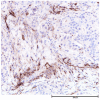Tumor Microenvironment in Breast Cancer-Updates on Therapeutic Implications and Pathologic Assessment
- PMID: 34439387
- PMCID: PMC8394502
- DOI: 10.3390/cancers13164233
Tumor Microenvironment in Breast Cancer-Updates on Therapeutic Implications and Pathologic Assessment
Abstract
The tumor microenvironment (TME) in breast cancer comprises local factors, cancer cells, immune cells and stromal cells of the local and distant tissues. The interaction between cancer cells and their microenvironment plays important roles in tumor proliferation, propagation and response to therapies. There is increasing research in exploring and manipulating the non-cancerous components of the TME for breast cancer treatment. As the TME is now increasingly recognized as a treatment target, its pathologic assessment has become a critical component of breast cancer management. The latest WHO classification of tumors of the breast listed stromal response pattern/fibrotic focus as a prognostic factor and includes recommendations on the assessment of tumor infiltrating lymphocytes and PD-1/PD-L1 expression, with therapeutic implications. This review dissects the TME of breast cancer, describes pathologic assessment relevant for prognostication and treatment decision, and details therapeutic options that interacts with and/or exploits the TME in breast cancer.
Keywords: breast cancer; fibrotic focus; stromal response; tumor infiltrating lymphocytes; tumor microenvironment.
Conflict of interest statement
The authors declare that there is no conflict of interest regarding the publication of this paper.
Figures







References
-
- Stakheyeva M., Riabov V., Mitrofanova I., Litviakov N., Choynzonov E., Cherdyntseva N., Kzhyshkowska J. Role of the Immune Component of Tumor Microenvironment in the Efficiency of Cancer Treatment: Perspectives for the Personalized Therapy. Curr. Pharm. Des. 2017;23:4807–4826. doi: 10.2174/1381612823666170714161703. - DOI - PubMed
-
- Salgado R., Denkert C., Demaria S., Sirtaine N., Klauschen F., Pruneri G., Wienert S., Van den Eynden G., Baehner F.L., Penault-Llorca F., et al. The evaluation of tumor-infiltrating lymphocytes (TILs) in breast cancer: Recommendations by an International TILs Working Group 2014. Ann. Oncol. 2015;26:259–271. doi: 10.1093/annonc/mdu450. - DOI - PMC - PubMed
-
- Choi W.W., Lewis M.M., Lawson D., Yin-Goen Q., Birdsong G.G., Cotsonis G.A., Cohen C., Young A.N. Angiogenic and lymphangiogenic microvessel density in breast carcinoma: Correlation with clinicopathologic parameters and VEGF-family gene expression. Mod. Pathol. 2005;18:143–152. doi: 10.1038/modpathol.3800253. - DOI - PubMed
Publication types
LinkOut - more resources
Full Text Sources
Research Materials

